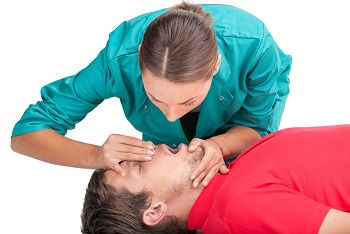Do I still need to give mouth-to-mouth resuscitation with CPR?
- jude72
- Aug 24, 2023
- 3 min read
Updated: Jan 28

When you think of helping someone who has nearly drowned, had a heart attack or gone unconscious, do you automatically think of using “mouth to mouth” resuscitation as part of your first aid?
For many people, especially if you are over say 45, this is exactly what might spring to mind.
Even the term “mouth to mouth” has become deeply embedded in our culture though movies, TV and the media. We hear people taking about having to give someone "mouth to mouth" or we see characters doing it.
This is because Mouth to Mouth Resuscitation was originally made the standard in first aid training way back in the 1960s. At the time it was called “Airways, Breathing, Circulation” or the “ABC” method.
Now at the time mouth-to-mouth resuscitation was introduced, it was combined with chest compressions and CPR, which was a great improvement on the previous methods of resuscitation. (Believe it or not, people used to use bellows or try moving a person’s arms up and down to try to resuscitate them!)
However since the 1960s there has been a lot of research in the US into mouth-to-mouth resuscitation and CPR. By analysing the cases of thousands of patients, they have discovered that it can, in many cases, be better just to perform the chest compressions component of CPR on its own, rather than include "mouth to mouth" breathing.
By the way, the new term for mouth-to-mouth is called “rescue breaths”, so even the name of it has changed.
There are many cases where it is still recommended to combine the two but it’s too complicated to get into which situations this applies to here.
Please note that in Australia there has been no change to the first aid training methods. We still do include learning how to perform rescue breaths (or mouth-to-mouth) along with chest compressions when performing CPR. Unfortunately, a lot of stories in the media have carried the news from the US that they have dropped it and that has made the situation very confused.
In this post Covid world the situation has become more complicated because people naturally are more reluctant to put their mouths on the mouths of complete strangers these days due to the fear that Covid spread among us all. (Unfortunately this has made some people also wary of giving assistance to anyone injured when it’s needed most, which is a shame.)
So to be clear, in Australia the ideal situation is to combine giving rescue breaths (mouth-to-mouth) with chest compressions when performing CPR. However, IF you are uncomfortable with the idea of putting your mouth on the mouth of a complete strange, you can choose to do CPR without rescue breaths. There will be no consequences for you if you do this.
These days, many first aid kits include a CPR breathing mask which allows you perform rescue breaths without actually making mouth-to-mouth contact with the person you are trying to resuscitate. If one of those is available and it helps reassure you then please use it.
As we always say - it's best to do something than nothing at all. So if the idea of mouth to mouth contact with a complete stranger stops you giving them CPR when they desperately need it, then don't worry about the mouth to mouth contact and just go ahead and do the CPR alone. Pumping a person’s chest up and down with your hands is what keeps oxygenated blood pumping through the body and this helps to keep vital organs alive, even without the mouth to mouth component.
Remember that if you do perform CPR on someone you can increase their chance of survival by up to 300%, so it’s vital that you are not put off by the thought of “having” to give the person “mouth to mouth”.
Of course, if you don’t know how to do CPR properly you should book in a course with Melbourne’s leading first aid trainers at https://www.resultsfirstaid.com/courses








Comments